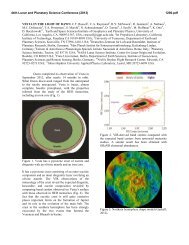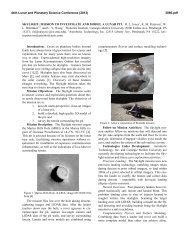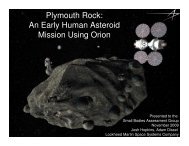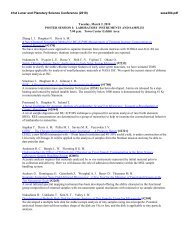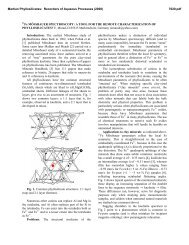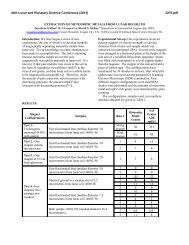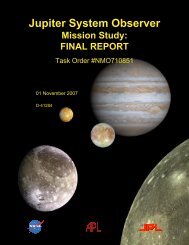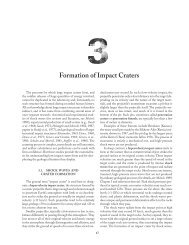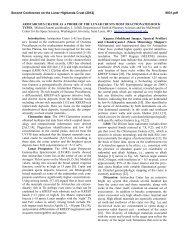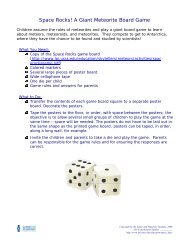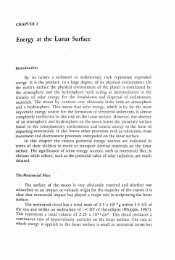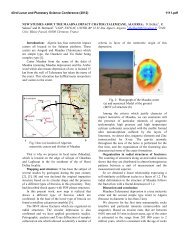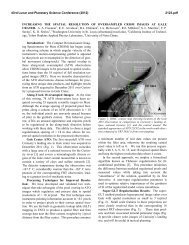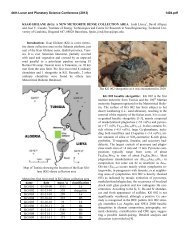Electromagnetic Sounding of Solid Planets and Satellites
Electromagnetic Sounding of Solid Planets and Satellites
Electromagnetic Sounding of Solid Planets and Satellites
Create successful ePaper yourself
Turn your PDF publications into a flip-book with our unique Google optimized e-Paper software.
comparison to the vertical E (38). Only B-field<br />
methods have been used heret<strong>of</strong>ore in<br />
planetary exploration because <strong>of</strong> their<br />
simplicity; E-field measurements are more<br />
challenging at low frequencies <strong>and</strong> noninductive<br />
contributions to E must be identified.<br />
Nonetheless, those methods using E have the<br />
significant advantage <strong>of</strong> complete soundings<br />
from a single vehicle that do not require a<br />
priori knowledge or special conditions.<br />
5. Interpretation<br />
In a parametric sounding, the impedance as<br />
a function <strong>of</strong> frequency is inverted to<br />
determine the conductivity as a function <strong>of</strong><br />
depth. Inverse methods are highly developed<br />
<strong>and</strong> robust (39,40). Resolution is geometric<br />
<strong>and</strong> is typically several percent <strong>of</strong> the depth.<br />
Overall, the thickness <strong>of</strong> a relatively resistive<br />
unit overlying a relatively conductive unit is<br />
well determined, whereas the thicknessconductivity<br />
product <strong>of</strong> a conductor overlying<br />
a resistor is recovered. Deep soundings<br />
usually fall in the former category, because<br />
increasing temperatures with depth dominate<br />
conductivity (e.g., Fig. 1). Saline water (Mars<br />
or icy satellites) is a near-ideal target.<br />
These vertical pr<strong>of</strong>iles can be interpreted<br />
directly, especially where major discontinuities<br />
are evident (e.g., 4-6). Advanced approaches<br />
use laboratory measurements <strong>of</strong> electrical<br />
conductivity to convert inverted quantities to<br />
subsurface temperature <strong>and</strong>/or composition<br />
(e.g., 1-3). Although the shallow subsurface<br />
can be very heterogeneous, there are a limited<br />
number <strong>of</strong> factors that can affect deep<br />
conductivity (see above). The increasing sophistication<br />
<strong>of</strong> interpretation leads to data<br />
products that fit NASA definitions (Table 5).<br />
Table 5. EM Data Products<br />
Level 1A Raw time series or spectra<br />
Level 1C Impedance vs. Frequency<br />
Level 2 Conductivity vs. Depth<br />
Level 3 Temperature/Composition<br />
vs. Depth<br />
5<br />
Figure 1. Lunar EM sounding interpreted using<br />
laboratory data (14). Top panel: Estimated<br />
limits on electrical conductivity vs. radius from<br />
magnetic transfer-function data. Middle panel:<br />
Laboratory temperature-conductivity data for<br />
pyroxenes, olivines, <strong>and</strong> a bulk model for the<br />
lunar interior below several hundred km.<br />
Bottom panel: Derived lunar temperature-depth<br />
pr<strong>of</strong>ile. Shaded area represents range <strong>of</strong><br />
temperature pr<strong>of</strong>iles based on electrical<br />
conductivity limits. Trace quantities <strong>of</strong> H2O in<br />
the lunar mantle can also meet temperature<br />
constraints without invoking high alumina (41).



